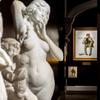An Image is Worth 1000 Words: The Triptych
- April 19, 2011 12:57
Whether it's meant to tell you what to wear, what to eat or what to admire, images surround us in our media-rich society. But not that long ago, images served a much higher purpose. Images were a visual representation of the world and its principles of both order and morality. Various forms of ecclesiastical art immerged primarily to convey these principles to the masses, and the triptych was one of the first of these stunning art forms.
Often referred to as the "traveling icon," the triptych, whether painted or carved, was a portable, convenient, and often times breathtaking work of art that told some sort of story of religious significance. In times when the ability to read was truly a luxury, even those untutored in letters could understand the incredibly detailed images artists created. Even the use of the three panels was significant in representing the Christian Holy Trinity. This beautiful Austrian Ivory Triptych depicts the veneration of the Virgin Mary and the infant Jesus. As you can see, the central panel is the primary focus, with the flanking panels supporting the theme.
As years progressed, the triptych evolved and became used for depicting secular stories. Take these Queen Elizabeth I and Mary, Queen of Scots triptychs, pictured to the right. With the Elizabeth triptych, her hinged skirt opens to reveal a courtly scene with two panels depicting two pivotal figures in the Queen's life, Mary Queen of Scots (who tried to have Elizabeth dethroned) and Lord Robert Dudley, the love of Elizabeth's life. Within Mary's triptych, the queen's skirt opens to reveal a scene of the Catholic queen and her supporters above the inscription "Maria Stuart." This scene is supported by the images of a court musician, and the other, the queen's masked executioner (Elizabeth did not take the dethroning attempt very lightly).
Without saying a word, the triptych has the power to tell a story-to enlighten and bring to life events from our distant (or not so distant) past. Regardless of the tale being told, these exquisite little rarities will continue to fascinate and delight collectors for generations to come.
To view M.S. Rau Antique's selection of triptychs, click here.
To view M.S. Rau Antique's selection of religious art, click here.






100x100_n.jpg)
100x100_c.jpg)













